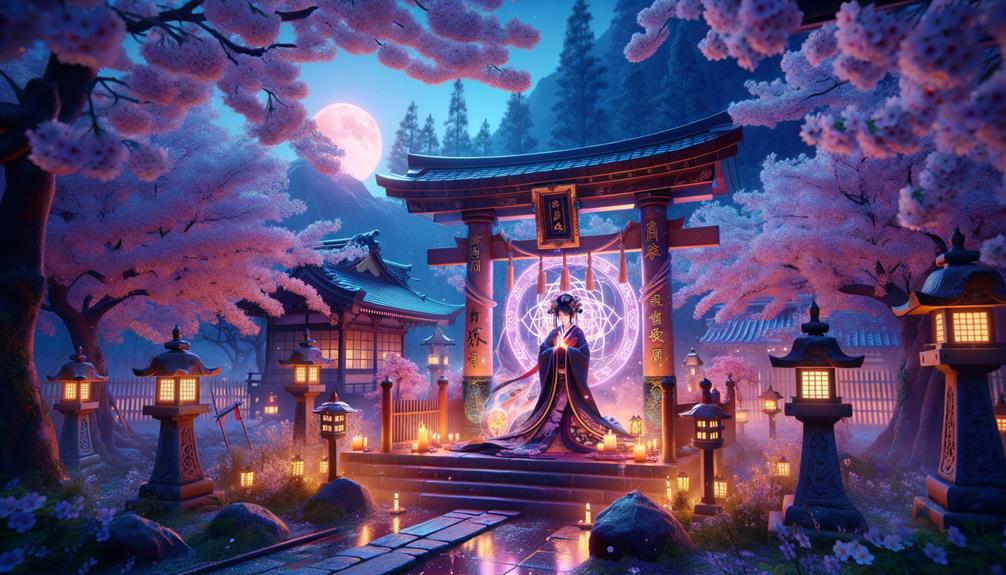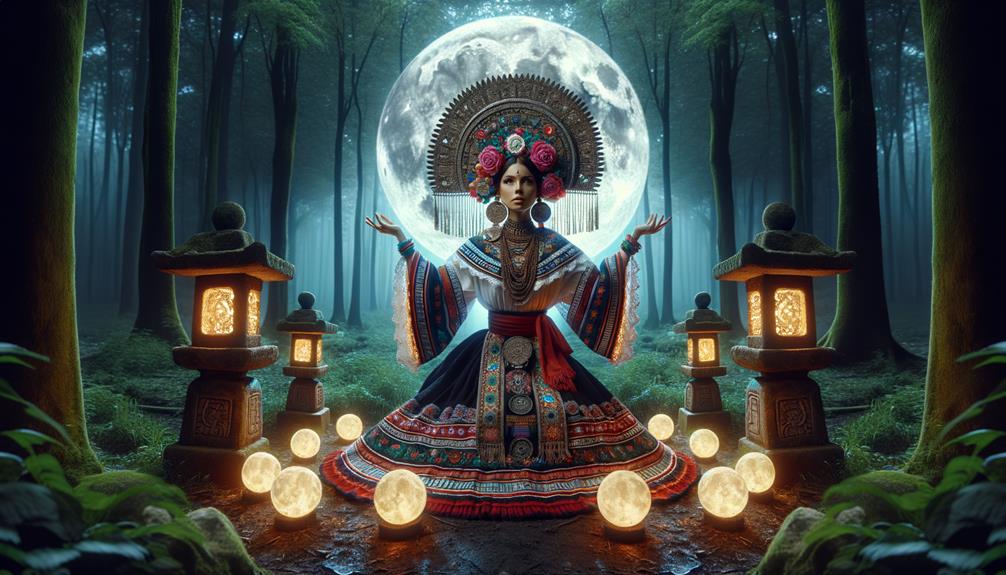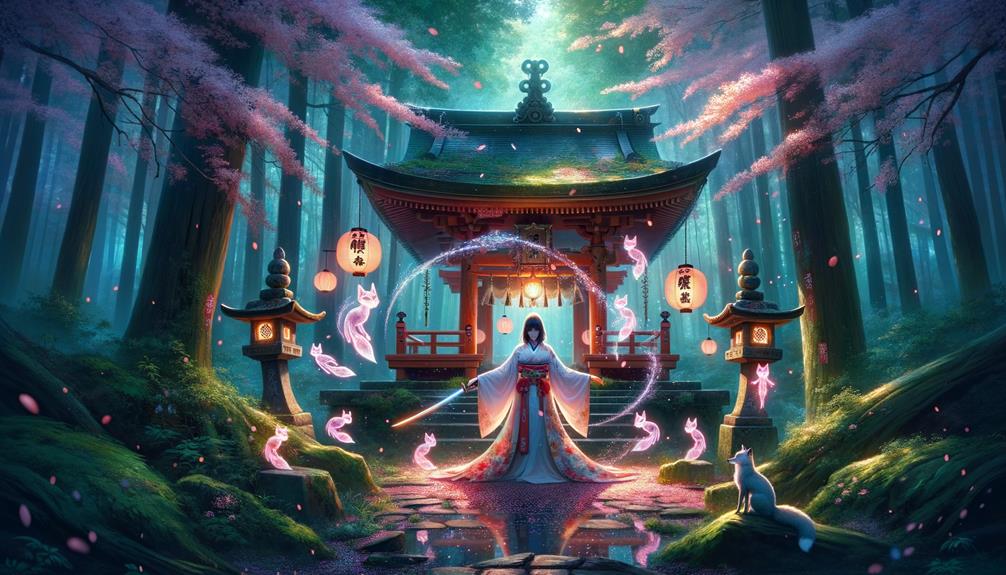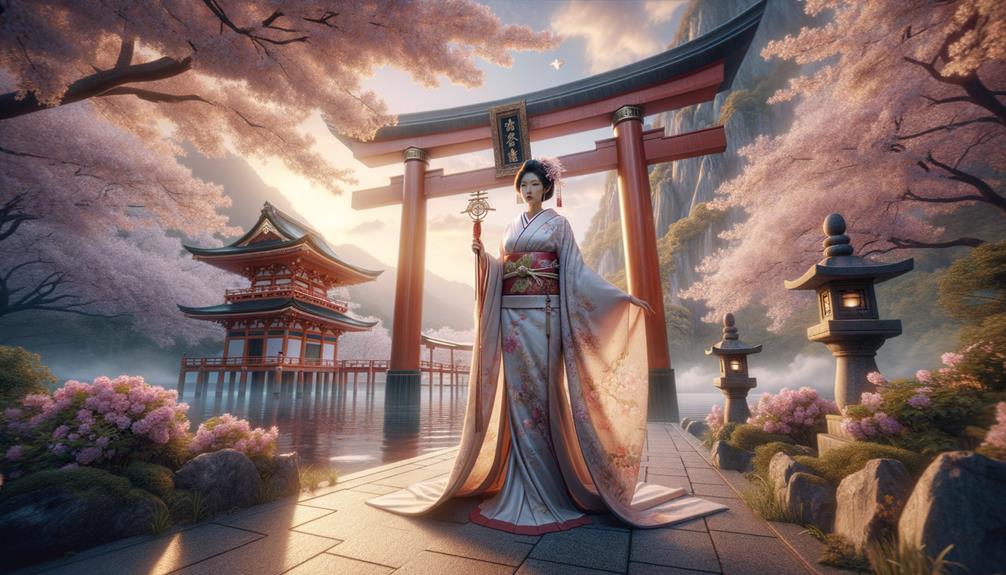Once upon a time, a young maiden named Hironari was chosen by divine forces to serve at a sacred shrine. Her journey began with intensive training from elder priestesses, mastering sacred rituals and spiritual arts. Donning white and red robes that symbolized purity and fierce protection against darkness, Hironari confronted malevolent entities and cleansed the land. Just as she thought her trials ended, a greater challenge emerged.
Origins and Background
In ancient Japan's mystical Heian era, certain young women were recognized for their remarkable spiritual abilities and purity. Guided by seasoned priestesses, these girls undertook rigorous training to become shrine maidens – guardians straddling the earthly and supernatural realms.
Envision a humble village girl suddenly immersed in rituals and ceremonies, her life forever altered. Under her mentors' watchful eyes, she mastered the intricate arts of spiritual mediation. This profound transformation saw her evolve from an ordinary existence to one steeped in divine purpose, epitomizing grace and dedication through disciplined practice.
Her journey was fraught with challenges – malevolent forces relentlessly disrupting the delicate equilibrium she strived to maintain. Yet each obstacle only tempered her resilience, cementing her status as a symbol of hope against supernatural adversity.
The shrine maiden's tale is one of perseverance amidst trials, vividly illustrating the human capacity for growth and courage when guided by ancient wisdom and virtues like fortitude and purity.
Sacred Duties

As the new Hironari Shrine Maiden Heroine, my sacred tasks called me to perform rituals bridging our world and the divine realm. Through providing spiritual guidance and community healing practices, I became a connection between humanity and the gods. Each blessing bestowed and festival led brought me closer to my true calling.
Rituals and Ceremonies
In the serene Hironari shrine, shrine maidens hold the sacred responsibility of bridging the mortal world and the divine realm. As a shrine maiden, I perform purification rituals that cleanse both the shrine's grounds and the spirit. This purification maintains the sanctity of our sacred space.
Through daily ceremonies, chants, and dances, I offer prayers and blessings, connecting with the spiritual dimension. Visitors seek guidance and protection, and my role channels the wisdom and grace of the kami. Every movement and melody pays tribute to the divine, a timeless connection transcending the physical world.
Maintaining the shrine's cleanliness and order is a manifestation of our reverence and humility. These sacred duties embody grace, humility, and reverence, making me a living bridge between our world and the divine.
Spiritual Guidance Role
Every morning, the first hues of dawn greet me as I step into the sacred courtyard, ready to fulfill my role as the community's spiritual guide and mentor. It's a journey that begins with the simple yet profound act of maintaining the shrine's cleanliness – a ritual symbolizing purity and order. Through prayers, blessings, and ancient rites, I serve as a conduit, connecting our world to the divine realm beyond.
| Duty | Symbolism | Impact |
|---|---|---|
| Maintaining Cleanliness | Purity | Harmonious Environment |
| Offering Prayers | Divine Connection | Spiritual Nourishment |
| Performing Rituals | Cultural Heritage | Community Cohesion |
| Seasonal Festival Dances | Tradition | Honoring Beliefs |
| Sacred Chants | Reverence | Fostering Sacredness |
Within these sacred duties, I embody grace and reverence, treading a path paved by age-old traditions. Each act, be it a sacred dance or a solemn chant, propels me further on this journey of dedication and humility. As I guide others, I too am guided, learning the profound depths of devotion. My role as a spiritual guardian is not merely a duty but a calling, a source of light and solace for our community.
Community Healing Practices
My devotion to these sacred duties stems from a profound belief that each act of community healing brings us closer together. I begin by offering prayers and blessings to those seeking spiritual guidance. These rituals connect us to realms beyond the physical, ensuring our spirits remain aligned.
Maintaining the shrine's cleanliness isn't a mere chore – it's a sacred act that creates an environment of tranquility and reverence. This harmonious space allows healing to commence.
Seasonal festivals weave our cultural heritage into daily life, uniting us. Through sacred dances and chants, I invoke energies that protect and heal. Each movement carries ancient wisdom, resonating through generations to touch our community.
Providing spiritual counsel is my purpose. In those moments, I embody nurturing compassion, becoming a source of strength for those in need. This shared journey fosters unity transcending the physical realm.
Spiritual Powers

With reverence for her ancestral wisdom, Hironari taps into spiritual energies, navigating the realms of the living and the divine. Her odyssey casts her as the enduring heroine, embodying the shrine maiden who stands at the threshold of worlds. Hironari's gifts emerge not through serendipity but through arduous training and unwavering commitment. Each ritual, prayer, and dance fortifies her bond with the spiritual sphere.
Hironari's abilities allow her to purify spaces, dispel malicious entities, and receive divine counsel. These acts preserve harmony and equilibrium within her community. Through sacred techniques, she channels energies that safeguard and heal, ensuring her people remain under the benevolent watch of the gods. She becomes a resolute guardian, shielding against unseen threats lurking in the shadows.
Her journey transcends mere mastery of these powers; it demands comprehending the delicate equilibrium between the physical and spiritual realms. As a shrine maiden heroine, Hironari serves as the conduit, the bond that upholds the harmonious coexistence of both spheres.
Symbolic Attire

Donning the red hakama and white kosode as the Hironari Shrine Maiden Heroine carries profound meaning. These garments signify purity and a deep spiritual connection, rooting me in sacred traditions. The hair ribbons further symbolize devotion, guiding my reverent path. This symbolic attire isn't just clothing; it's a representation of my sacred duties.
Traditional Garb Significance
In the heart of the shrine, the maiden dons white and red attire, transforming herself into a living symbol of purity and divine connection, prepared to begin her sacred duties. These robes aren't just cloth; they signify her role as an intermediary between humans and spirits.
The white fabric represents purity and cleanliness, essential qualities for a maiden serving as a bridge to the divine realm. In contrast, the red acts as a shield against malevolent forces. This duality in her attire reveals her dual purpose: to bring spiritual energy to the community while protecting it from harm.
Her accessories—hair ribbons and bells—carry symbolic weight. The ribbons signify her connection to the sacred, while the bells purify the surrounding space, warding off evil forces. These elements aren't mere decorations but integral parts of her hallowed duty.
This attire has been passed down for generations, imbued with cultural and spiritual significance. Clothed in tradition, she steps into her role, ready to fulfill her destiny as a spiritual guide for her people.
Color Palette Meaning
The shrine maiden's stark white and vivid red ensemble serves dual purposes—upholding purity while warding off malice. White symbolizes spiritual cleanliness, as if shielding her from worldly contamination. She exudes an aura of sanctity, connecting to the divine realm.
Red, fiery and bold, personifies vigor and fortitude to combat evil forces. This hue transcends mere decoration; it's a lifeblood pulsing through her, a formidable defense mechanism.
Together, these contrasting yet complementary shades form a symbiotic balance. White represents heavenly purity while red embodies earthly tenacity. Her sashed hair further roots her in the spiritual dimension as an envoy between worlds. This carefully curated palette isn't just tradition—it manifests her sacred calling.
Notable Legends

The legends of the Hironari Shrine Maiden Heroine originate from Japanese folklore, depicting a brave young woman armed with a sacred blade and potent spells. Her tale begins as sinister spirits threaten her peaceful village, prompting her to embark on a dangerous quest.
Embodying purity and selflessness, the heroine answers the call. Her divine blade symbolizes spiritual fortitude and divine safeguarding. Along the way, various trials challenge her resolve, yet she remains dedicated, battling malevolent forces.
Following the archetypal hero's journey, she faces near-defeat but rises through sheer willpower and her spells' might. In the climax, she triumphs over the ultimate evil, not merely through combat prowess but profound spiritual connection and inner purity.
Generations find inspiration in the Hironari Shrine Maiden Heroine's tale, celebrating heroism, sacrifice, and good's triumph over wickedness.
Cultural Impact

As the heroine's legendary accomplishments amaze us, her influence in Japan's popular culture and media becomes profoundly undeniable. The Hironari Shrine Maiden Heroine, embodying purity, devotion, and spiritual strength, emerges as a pivotal figure across various entertainment forms. From anime to video games, the archetype of the strong, spiritual young woman deeply rooted in nature and the supernatural resonates powerfully with audiences.
Her journey mirrors the hero's tale, symbolizing the call to adventure – a bridge between the ordinary and the mystical. This connection to Shinto traditions highlights society's enduring fascination with the mystical realm, where spiritual battles and sacred duties intertwine. Her narrative often follows the monomyth structure, with trials and transformations echoing timeless themes of growth and self-discovery.
| Medium | Example | Impact |
|---|---|---|
| Anime | 'Inari, Konkon, Koi Iroha' | Depicts spiritual and emotional maturation. |
| Manga | 'Noragami' | Explores divine alliances and human interactions. |
| Video Games | 'Okami' | Embodies the balance between nature and civilization. |
Frequently Asked Questions
Can Shrine Maidens Marry?
On my personal quest for knowledge, I uncovered that shrine maidens can marry, though their paths are as unique as a winding river. Each shrine has distinct guidelines, making the decision a highly personal choice that invites contemplation.
What Does Miko Mean in Japanese?
Miko, a term rooted in Japanese tradition, refers to a woman who guides spiritual rituals and serves as a bridge between the human realm and the spiritual world. They embody purity and hold a deep connection to the divine, guiding others on a path towards inner harmony and balance. As intermediaries between mortals and the unseen forces that govern the cosmos, miko play a crucial role in preserving ancient practices and upholding the delicate equilibrium of the universe.
What Is the Male Equivalent of a Shrine Maiden?
Comparable to shrine maidens, shrine priests or shugenjas serve as spiritual intermediaries between humans and deities. Cloaked in traditional garments, they oversee rituals and ceremonies, embarking on a sacred path. Their roles mirror those of their female counterparts, guiding devotees on a spiritual journey.
What Are the Duties of a Miko?
As a miko, my role encompasses preserving the sanctity and traditions of the shrine. I conduct rituals, bestow blessings, and offer spiritual guidance—serving as a bridge between the earthly realm and the divine through ancient practices and sacred dances. Maintaining purity remains a core responsibility throughout this journey.


